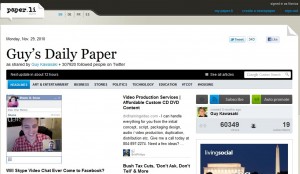 Back when I was editor-in-chief of my university’s student newspaper in the 1980s, it seemed we were on the cutting edge. We’d recently obtained some PCs, WordStar word-processing software, and a laser printer, so we could print out articles reporters typed themselves in columns ready for layout. It was so much easier than retyping and coding all the copy with an old phototypesetting machine.
Back when I was editor-in-chief of my university’s student newspaper in the 1980s, it seemed we were on the cutting edge. We’d recently obtained some PCs, WordStar word-processing software, and a laser printer, so we could print out articles reporters typed themselves in columns ready for layout. It was so much easier than retyping and coding all the copy with an old phototypesetting machine.
Even with the new technology, however, laying out the newspaper still took several hours of hard work. In the days before desktop publishing, you had to put wax on the back of printed out newspaper text and photos, paste them where you wanted them on a page, and then use a special tape to add borders and boxes.
Flash forward to today and the technological change is truly revolutionary. You not only don’t have to lay out anything to produce your own “newspaper,” you don’t have to write anything either. Yes, it’s true. Thanks to Paper.li, you can create your own free online daily “newspaper” in seconds by simply entering your Twitter user name. A few clicks later, a webpage will be created featuring the latest posts, pictures, video, and embedded links from the tweets of those you are following. This custom webpage really does look like a newspaper—complete with advertisements.
More than 1,000 Paper.li “newspapers” are created each day, and many are getting several hundred tweets and views. They are picking up subscribers too and not charging a penny.
Every couple of days an article I’ve tweeted about ends up being featured in somebody’s daily “newspaper.” An excerpt of the article appears on the page with my Twitter user name and photo as the source. I have to admit it makes me uncomfortable to see myself credited for tweeting about an article from a real newspaper, one undoubtedly losing circulation and revenues in a world where everyone can be an editor.